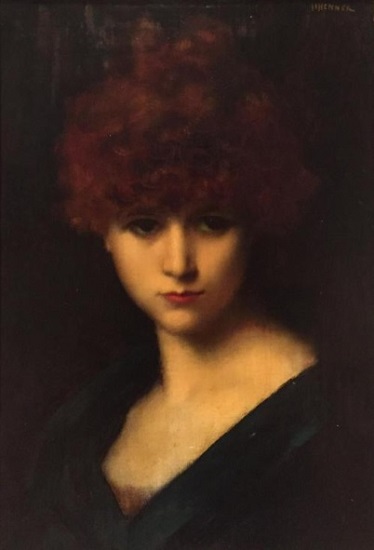
Jean-Jacques Henner
French, 1829-1905
Idealized Female Head (Tête d'expression), 1880s, late
oil on canvas mounted to panel
18 1/2 x 12 3/4 in.
SBMA, Gift of the A.E. Clegg Family
1991.89.5

Jean-Jacques Henner - photo ca 1900, published 1908 by Chocolats Félix Potin
RESEARCH PAPER
This female head by Jean Jacques Henner is an intimate portrait of an unknown red-headed beauty. Although her face is turned toward us and she is in a classic “portrait pose” her eyes are gazing down and outside of the picture frame. Overall the painting is dark, the only real illumination coming from the skin of her face and neck, which seem to glow with a warm golden light. Her garments create a strong diagonal that provides a gentle movement through the painting. The dark background, contrasting with the glowing light of her skin, brings to mind the dramatic chiaroscuro lighting of the high Renaissance. Using both chiaroscuro and sfumato painting techniques Henner creates a dreamlike hazy vision, of his subjects, elevating them to the supernatural realm.
The use of redheads in Henner’s paintings is a signature of his work. He was particularly fond of the color red in his paintings, and often used it to draw attention to the subject of the painting. Indeed the pop of color in this painting is the red of her lips and the warm, rich red tones of her hair.
Henner’s sfumato brushwork is another distinctive feature of his work. Sfumato is a painting technique where the edges of the subject are blurred and softened. This technique adds a dreamlike quality to the paintings, creating a sense of atmosphere and mystery. Henner used sfumato to draw the viewer into the painting, and to create a sense of depth and emotion.
Henner was able to create beautiful, mysterious, and emotionally charged works of art. His use of redheads and sfumato brushwork have become iconic elements of his paintings and have inspired other artists to create similarly striking works of art.
Henner was heavily impacted by the Italian artwork he encountered during his studies at the French Academy in Rome. His softened brushwork emulates the sfumato technique popularized during the Italian renaissance. The texture is minimal with only small visible bruchstrokes. The Italian influence is also felt with the dramatic chiaroscuro lighting.
Henner was born in 1829 in Alsace, France. He is best known for his portraits and religious paintings. He studied at the Ecole des Beaux Arts in Paris, and his works were exhibited at the Salon de Paris. He was highly regarded by his contemporaries, and his work was widely collected.
Henner’s most famous works are his portraits, which often depicted women in a contemplative state. He used a muted palette and soft brushstrokes to create a sense of intimacy and emotion. He was known for his ability to capture the subtle nuances of his subjects’ expressions and emotions. He also painted several religious works, which were often inspired by his Catholic faith.
Henner achieved great success in his lifetime and was awarded the Legion of Honor in 1881. He was also a professor at the Ecole des Beaux Arts and a professor at the Academie Julian. He was a mentor to many younger artists, and his influence can be seen in the works of his students.
Henner’s legacy is one of a masterful painter who was able to capture the subtle nuances of his subjects’ expressions and emotions. His works are highly sought after today, and his influence can still be seen in the works of many contemporary artists. He is remembered as one of the greatest French painters of the 19th century and his works continue to inspire new generations of artists.
Prepared for the Santa Barbara Museum of Art Docent Council by Kristin Frascella, Spring 2023
Bibliography
Contributors to Wikimedia projects. “Jean-Jacques Henner - Wikipedia.” Wikipedia, the Free Encyclopedia, Wikimedia Foundation, Inc., 18 Dec. 2004, https://en.wikipedia.org/wiki/Jean-Jacques_Henner.
Crastre, François. Henner, by Fr. Crastre. Createspace Independent Pub, 1913.
“Homepage | Musée National Jean-Jacques Henner.” Page d’accueil | Musée National Jean-Jacques Henner, https://musee-henner.fr/en. Accessed 25 Jan. 2023.
“Jean-Jacques Henner.” Encyclopædia Britannica, Encyclopædia Britannica, https://www.britannica.com/biography/Jean-Jacques-Henner. Accessed 25 Jan. 2023.
